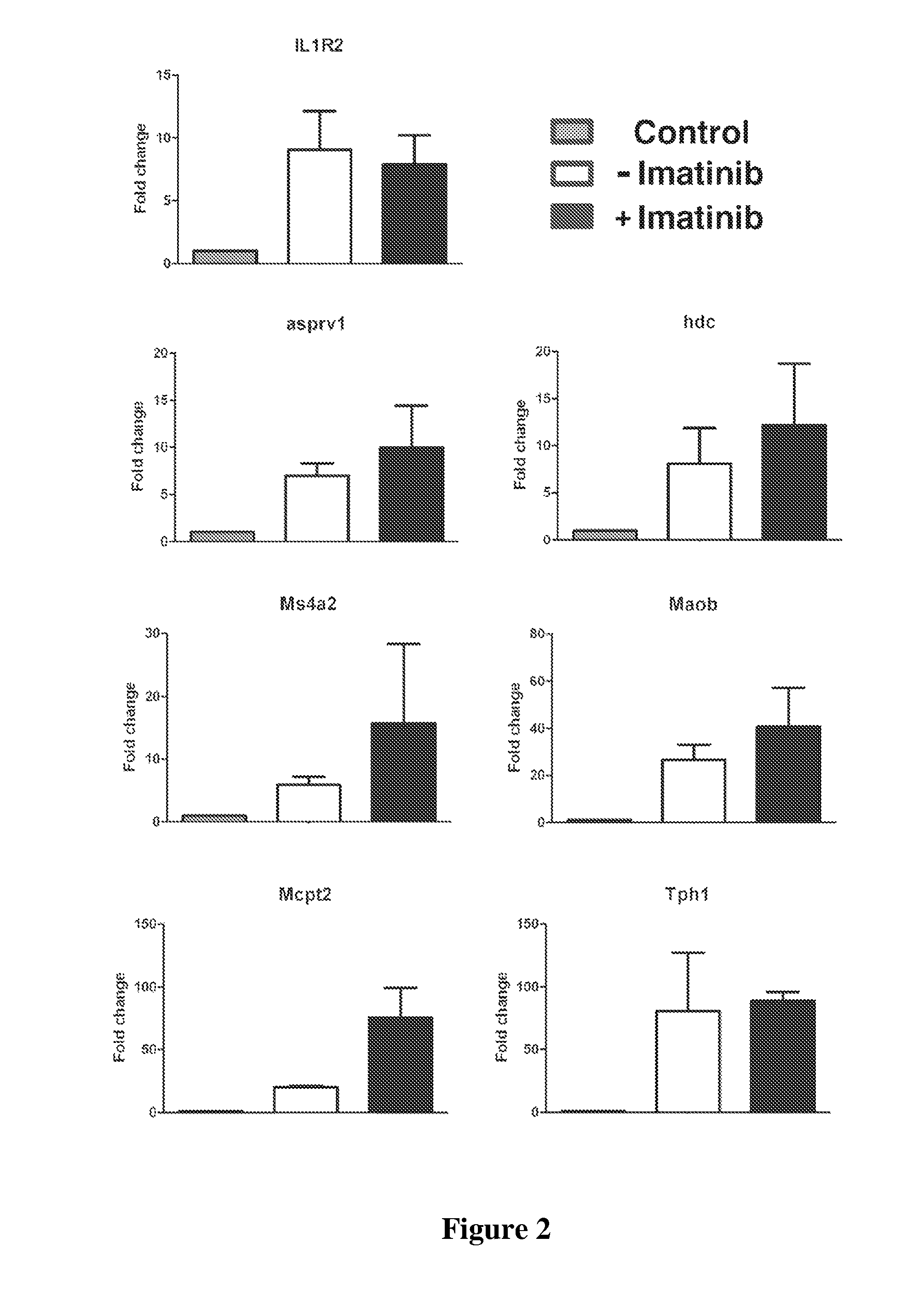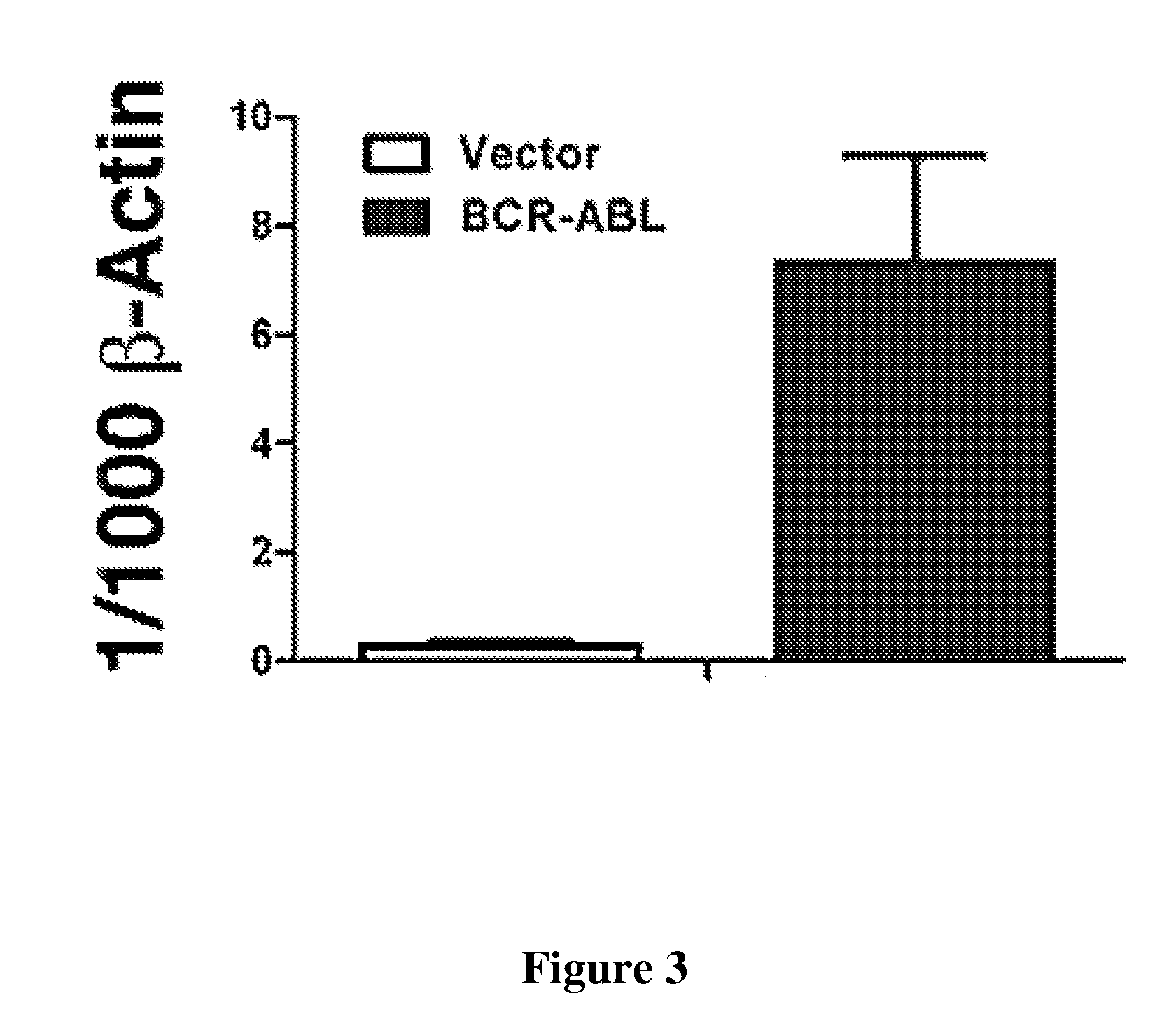Methods and compositions relating to hematologic malignancies
a technology of hematologic malignancies and compositions, applied in the field of hematologic malignancies, can solve the problems of rapid death and abnormal new hematopoietic tissues
- Summary
- Abstract
- Description
- Claims
- Application Information
AI Technical Summary
Problems solved by technology
Method used
Image
Examples
example 1
Identification of Alox5 in CML
[0358]Leukemic stem cells in CML (CML-SCs) are insensitive to BCR-ABL kinase inhibitors (Graham et al., 2002). A bone marrow transplantation (BMT) mouse model of CML is used as an assay system, in which bone marrow cells from donor mice pretreated with 5-fluorouracil (5-FU) and transduced with BCR-ABL result in development of CML in recipient mice (Li et al., 1999). Bone marrow cells from C57BL / 6 (B6) mice are transduced with retrovirus containing BCR-ABL / GFP or GFP alone under conditions for induction of CML, followed by transplantation of the transduced cells into B6 recipient mice. Some mice are treated with the BCR-ABL kinase inhibitor imatinib (150 mg / kg body weight / per dose, once every 4 hours; orally by gavage) for 5 doses beginning at day 13 post bone marrow transplantation (BMT) to allow identification of genes that are altered by BCR-ABL in LSCs, but this alteration is not restored by inhibition of BCR-ABL kinase activity with imatinib. Some p...
example 2
Alox5 is Essential for CML Induction by BCR-ABL
[0363]Alox5 homozygous knockout (Alox5− / −) mice are used in this example to determine the effect of Alox5 on LSC function. Wild type or Alox5− / − donor bone marrow cells on the B6 strain background are used to induce CML.
[0364]Kaplan-Meier survival curves for recipients of BCR-ABL-transduced bone marrow cells from wild type or Alox5− / − donor mice (10 mice per group) are determined. Recipients of BCR-ABL-transduced bone marrow cells from 5-FU-treated wild type donor mice developed and died of CML within 4 weeks, whereas recipients of BCR-ABL-transduced bone marrow cells from Alox5− / − donor mice are resistant to induction of CML and survived, as shown in FIG. 5. This defective disease phenotype correlates with much less severe infiltration of myeloid leukemia cells in the lung and spleen. Gross appearance of the lungs and spleens showed severe lung hemorrhages and splenomegaly of recipients of BCR-ABL-transduced bone marrow cells from wild...
example 3
Alox5 Rescues Defective CML
[0367]BCR-ABL and Alox5 are co-expressed in Alox5− / − and wild type bone marrow cells, respectively, in this example by retroviral transduction, followed by transplantation of the transduced cells into recipient mice.
[0368]293T cells are transfected with mock, BCR-ABL-IRES-GFP-pMSCV or BCR-ABL-IRES-Alox5-pMSCV. BCR-ABL and 5-LO expression are detected by Western blotting using antibodies against Abl and 5-LO. The BCR-ABL-IRES-Alox5-pMSCV construct expresses both, BCR-ABL and ALOX5 in 293T cells as shown in FIG. 7a. Bone marrow cells from B6 mice are transduced with retrovirus containing IRES-GFP-pMSCV (empty vector) or BCR-ABL-IRES-Alox5-pMSCV, and then transferred into B6 recipient mice to induce CML. The plasma level of LTB4 in recipients of BCR-ABL-IRES-Alox5-pMSCV-transduced bone marrow cells is significantly higher than that in recipients of bone marrow cells transduced with empty vector-containing retrovirus (pb. In contrast to the lack of CML inducti...
PUM
 Login to View More
Login to View More Abstract
Description
Claims
Application Information
 Login to View More
Login to View More - R&D
- Intellectual Property
- Life Sciences
- Materials
- Tech Scout
- Unparalleled Data Quality
- Higher Quality Content
- 60% Fewer Hallucinations
Browse by: Latest US Patents, China's latest patents, Technical Efficacy Thesaurus, Application Domain, Technology Topic, Popular Technical Reports.
© 2025 PatSnap. All rights reserved.Legal|Privacy policy|Modern Slavery Act Transparency Statement|Sitemap|About US| Contact US: help@patsnap.com



